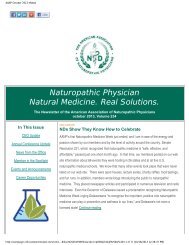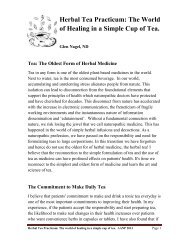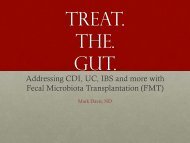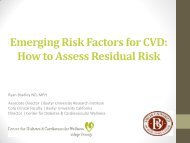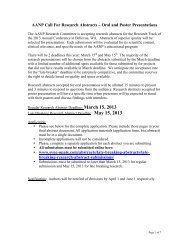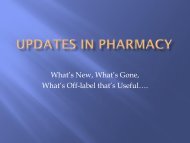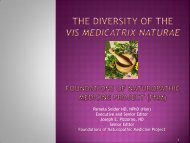Mushrooms - The Fungal Pharmacy
Mushrooms - The Fungal Pharmacy
Mushrooms - The Fungal Pharmacy
Create successful ePaper yourself
Turn your PDF publications into a flip-book with our unique Google optimized e-Paper software.
<strong>Mushrooms</strong>:<br />
Our <strong>Fungal</strong> <strong>Pharmacy</strong><br />
Sara Thyr, ND
Fungi Characteristics<br />
• 100,000 described species<br />
• Mycologists estimate may be more than 1.5<br />
million species<br />
• Classified in kingdom Fungi (eukaryotic)<br />
• Can grow to enormous size – 1500 acres
• Are decomposers<br />
Fungi<br />
• Absorb nutrients from their environment<br />
• Break down organic matter from dead<br />
organisms, leaves, garbage and other waste<br />
• When break down organic compounds, are<br />
released into environment where are recycled
Form vital symbiotic relationships<br />
• Most terrestrial plants have fungal partners<br />
• Live in close association with roots<br />
• Help plants obtain phosphate ions and other<br />
minerals from the soil<br />
• Lichens are symbiotic relationship of fungi<br />
and algae or cyanobacteria
How fungi get nutrients<br />
• Like animals, fungi are heterotrophs<br />
• Absorb food from environment (preformed<br />
carbon molecules)<br />
• Infiltrate a food source and secrete digestive<br />
enzymes onto it<br />
• Rapidly converts nutrients into new cell material
Structure - chitin<br />
• Cell walls contain chitin (a complex<br />
carbohydrate)<br />
• Chitin is also component of external skeletons<br />
of insects and other arthropods<br />
• Chitin is resistant to breakdown by most<br />
microorganisms
Structure
Structure<br />
• Fungi contain network of filaments<br />
• Multicellular body contains long, branched threadlike<br />
filaments called hyphae<br />
• As hyphae grow, a tangled mass or network called<br />
mycelium is formed<br />
• Spores (for those w sexual reproduction) produced on<br />
fruiting structures (sporangia - familiar part of mushroom<br />
is fruiting body)
Life cycle of fungi
Controversy in classification<br />
• Fungi are more closely related to animals than plants!<br />
• Like plants: have cell walls & vacuoles, are sessile; many inhabit the soil<br />
• Unlike plants: fungal cell walls do not contain cellulose (rather contain<br />
chitin – as in insect skeletons)<br />
• <strong>Fungal</strong> mode of nutrition differs from plants – cannot produce their own<br />
organic materials<br />
• Like animals, fungi are heterotrophs<br />
• Like animals, fungi have plate-like cristae in their mitochondria<br />
• Based on structural characters and molecular data, systematists now<br />
view fungi as more closely related to animals than to plants
5 Main <strong>Fungal</strong> Phyla
Glomeromycetes are symbionts<br />
with plant roots<br />
• Form intracellular association with roots of<br />
most trees and herbaceous plants<br />
• Assn. between hyphae of fungi and roots of<br />
plants are called mycorrhizae<br />
• Mutualistic symbiotic association – both<br />
benefit
• 32,000 species<br />
• Great impact on humans<br />
Ascomycetes<br />
• Make cheeses, bake bread, and eat (morels and truffles)<br />
• Produce antibiotics<br />
• Form mycorrhizae with tree roots<br />
• 40% join with algae or cyanobacteria to form lichens<br />
• Negative side: cause most fungal diseases of plants and<br />
animals
• Over 30,000 species<br />
Basidiomycetes<br />
• Largest and most familiar of the fungi<br />
• Many are decomposers that obtain nutrients by breaking<br />
down organic matter<br />
• Mushroom is formed as fruiting body – more formally –<br />
basidiocarp<br />
• Lower surface of the cap consists of many gills where<br />
basidiospores form
Reproduction
Ecological importance<br />
• Free-living decomposers – absorbing nutrients from organic wastes and<br />
dead organisms<br />
• Degrade cellulose and lignin, the main components of plant cell walls<br />
• Release water, CO2, and minerals – which are recycled<br />
• Without this continuous decomposition, essential nutrients would remain<br />
locked up in huge mounds of animal carcass, feces, branches, logs and<br />
leaves<br />
• <strong>The</strong> nutrients within them would not be unavailable for use by new<br />
generations of organisms<br />
• Life would eventually cease!!!
Symbiosis<br />
• Important symbiotic relationships w/ animals, plants,<br />
bacteria<br />
• 3-way symbiotic relationship w a fungus, a grass and a<br />
virus has recently been reported<br />
• In geothermal hot spots of Yellowstone<br />
• When has specific virus, fungus is heat tolerant and confers<br />
this to the grass (when virus not present, no heat<br />
tolerance)
Get along well w/ others<br />
• More than 200 species of ants farm fungi<br />
• 80% of plants have mycorrhizae<br />
• Many cannot grow well without their fungal partners<br />
• Improve soil by decreasing water loss and erosion<br />
• Can reclaim soils damaged by pollution<br />
• Mycorrhizae can modify toxic heavy metals, such as<br />
cadmium, so that plants cannot absorb them
Bioremediation<br />
• Some fungi can biodegrade pesticides,<br />
herbicides<br />
• Some break down coal tars and petroleum<br />
• Convert into CO2 and their basic elements<br />
• Fungi and bacteria can decontaminate farm<br />
land and clean up oil spills
Fuel Impact<br />
• Renewable fuel companies are researching fungi for fuel<br />
production<br />
• Recently a fungus was discovered than synthesizes 55<br />
hydrocarbons, perhaps to inhibit growth of other<br />
organisms<br />
• Researchers may be able to use the genes of this fungus to<br />
engineer other microorganisms to efficiently produce fuel
Fungi in Medicine<br />
• 1928 – Alexander Fleming discovered penicillin<br />
produced by the mold Penicillium notatum<br />
• Other Rx from fungi: cephalosporin ABx, statins,<br />
and cyclosporine<br />
• Claviceps purpurea infects rye and produces ergot<br />
– used to induce labor, stop uterine bleeding,<br />
treat HTN, and some migraines.
Penicillium conidiophores
Yummy!<br />
• Yeasts produce ethyl alcohol and carbon dioxide from<br />
sugars – beer and bread!!!<br />
• Roughly 200 species are edible (roughly 30 are found in<br />
supermarkets)<br />
• Cheeses such as Roquefort, Brie and Camembert not<br />
possible without species of Penicillium (the blue spots are<br />
masses of conidia)<br />
• But – watch out for the 70 poisonous species
Death cap (Amanita phalloides)
Medicinal <strong>Mushrooms</strong><br />
• Have been used in Chinese medicine for<br />
thousands of years<br />
• Western researchers are starting to catch on<br />
• Myriad mushrooms to discuss
Properties<br />
• Plant cell walls made of cellulose, beta 1-4<br />
linked glucose molecules<br />
• Fungi cell walls made of chitin, beta 1-3<br />
linked polysaccharide chain (1-3 , 1-6 b-<br />
glucan
<strong>Fungal</strong> beta glucan
Beta glucans<br />
• Yeast and oats also form beta glucans<br />
• Structure of mushroom beta glucans is more diverse<br />
• <strong>The</strong>refore have higher levels activity in immune system<br />
• Mushroom polysaccharides have immunological activity<br />
– 77.5% from mushroom fruiting body<br />
– 20.8% from mycelium<br />
– 2.0% from culture filtrate (broth)
• Proteins<br />
• Tripterpenes<br />
• Sterols<br />
• Chitin<br />
• Enzymes<br />
Active properties<br />
• Polysaccharides!! Most widespread
Proteins<br />
• Ling Zhi-8 (LZ-8) from Ganoderma lucidum (Reishi)<br />
• Fve, EA-6 and Flammulin from Flammulina velutipes (Enokitake)<br />
• Immune modulation – act on monocytes; effect T-cell activation<br />
• Ribosome inactivation<br />
• Anti-HIV – Velutin inhibits HIV reverse transcriptase<br />
• Anti-fungal<br />
• Nuclease activity<br />
• Lectins have been isolated from many mushrooms, including F.<br />
velutipes, Grifola frondosa and G. lucidum.
Triterpenes<br />
• Families of ganoderic and lucidenic acids from Ganoderma lucidum<br />
are best known, give it many therapeutic properties<br />
• Including: anti-cancer, anti-inflammatory, anti-histamine,<br />
hypotensive and sedative actions<br />
• Betulinic acid from Birch trees, taken up by Inonotus obliquus<br />
(Chaga) – anti-cancer, anti-inflammatory, and anti-viral<br />
• Antrodia camphorata – unique Taiwanese mushroom – high levels<br />
of triterpenes
Sterols<br />
• Principal sterol is ergosterol, with H. erinaceus<br />
fruiting body containing high amounts<br />
• Anti-tumor activity has been shown, as well as<br />
anti-angiogenic properties<br />
Isolation of an antitumour compound (Ergosterol) from Agaracus blazei Murill and its mechanism of action. Takaku T, Kimura Y, Okuda H. J Nutr.<br />
2001;131:1409-1413<br />
• Anti-aging activity on par with resveratrol<br />
Ganodermasides A and B, two novel anti-aging ergosterols from spores of a medicinal mushroom Ganoderma lucidum on yeast via UTH1 gene Weng Y,<br />
Xiang L, Matsuura A, Zhang Y, Huang Q, Qi J. Biorreg Med Chem. 2010;18(3):684-1002
Chitin<br />
• Primary component of fungal cell walls<br />
• Effects on innate and adaptive immune responses<br />
• Ability to recruit and activate innate immune cells<br />
• Can induce cytokine and chemokine production<br />
• Anti-bacterial and antioxidant activity<br />
• However is component of allergy-triggering allergens<br />
– including those in shrimp, crab and house dust mite
Enzymes<br />
• Digestive enzymes (proteases, lipases, etc.)<br />
• Antioxidant enzymes (laccase, catalase,<br />
superoxide dismutase [SOD])<br />
• SOD is acid-labile - no bioactivity<br />
• Tyrosinase – genoprotective effect in vitro
Polysaccharides – Key to Immune<br />
activity<br />
• Most widespread and most immunologically important<br />
• Profound impact on immune system<br />
• Mediated by a number of fungal polysaccharide-specific<br />
receptors on surface of several immune cell types<br />
• Key immune cells are hard-wired to respond to the<br />
presence of fungal polysaccharides<br />
• Immune system most likely evolved under constant<br />
challenge of fungal pathogens
Immune system activation by fungal beta glucans
<strong>Fungal</strong> Polysaccharides Effect on<br />
• Increase antibody production<br />
Immune System<br />
• Increase lymphocyte activating factor (IL-1) production<br />
• Increase tumor necrosis factor production<br />
• Increase colony stimulating factor production<br />
• Increase complement C3 production<br />
• Increase IFN-gamma production<br />
• Increase IL-2 production<br />
• Reduction in the level of IL-2 needed to produce a cytotoxic response<br />
• Th1 activation
Immune response (cont.)<br />
• Macrophage activation<br />
• Neutrophil activation<br />
• Cytotoxic T-cell activation<br />
• Lymphokine activated killer cell proliferation<br />
• Enhanced maturation and tumor infiltration of dendritic cells<br />
• Th2 suppression<br />
• Reduce IL-4 production<br />
• Inhibit prostaglandin synthesis<br />
• Inhibit delayed type hypersensitivity<br />
Powell, Martin. Medicinal <strong>Mushrooms</strong>: A Clinical Guide. Mycology Press. 2010.
Shift for Chronic Health Dso.<br />
• Mushroom polysaccharides promote shift in pattern of<br />
immune response<br />
• Cancer, auto-immune disorders, allergic health conditions<br />
• Shift from pro-inflammatory, Th2 dominant to cytotoxic,<br />
Th1 dominant<br />
• Increases especially critical are in Th1 cytokines such as IL-<br />
2, IFN-y<br />
• Decrease in Th2 cytokines such as IL-4
Extraction Process<br />
• Hundreds of mushroom products on shelves<br />
• Most research done on hot water extracts<br />
• Or hot water extracts w/ alcohol extract<br />
• Know what the process is for extraction<br />
• Human GI tract cannot break down chitin
Fruiting body or Conk<br />
• Fruiting body has highest level of different polysaccharides v<br />
mycelium or culture broth<br />
• Conk – sterile fungal growth on tree trunk (Inonotus obliquus)<br />
• Triterpenes in G. lucidum higher in fruiting body<br />
• Antrodia camphorata data show triterpenes in biomass 40% of that<br />
in fruiting body<br />
• Biomass products tend to have leftover substrate, not just<br />
mycelium
Extracts<br />
• Aqueous extracts (traditional teas/decoctions) give high<br />
polysaccharide concentrations but lower levels of triterpenes<br />
• Ethanol (alcohol) extracts yield more triterpenes but fewer<br />
polysaccharides<br />
• Some companies do both processes and combine in products<br />
• Extracts preferred in cases of gut dysbiosis or impaired ability<br />
to break down whole mushroom or biomass products
Spores<br />
• Fruiting body exists to spread spores in<br />
reproduction<br />
• Rich in fatty acids, which have some<br />
therapeutic action<br />
• G. lucidum spores v fruiting body show little<br />
difference in immunological activity
Mycelium (liquid/submerged<br />
fermentation)<br />
• Liquid fermentation is used in pharm industry to produce<br />
antibiotics (also fungal enzymes)<br />
• Controlled situation for nutrients and temperature to get<br />
most of desired components<br />
• Mycelium easily harvested from liquid and processed into<br />
extracts (PSK & Lentinan)<br />
• Metabolites secreted into broth may also be harvested<br />
(Schizophyllan – from Schizophyllum commune)
Mycelial Biomass (solid state<br />
fermentation)<br />
• Mushroom culture is inoculated into sterile, grain-based substrate<br />
(brown rice)<br />
• Once substrate is exhausted and about to produce fruiting bodies,<br />
mass of mycelium and residual substrate is dried and granulated<br />
• Extract contains antibiotics, exopolysaccharides, enzymes,<br />
antioxidants (catalase, SOD) and substrate breakdown products<br />
arabinoxylans (have own therapeutic value)<br />
• Examples are Biobran, MGN-3 (shitake digested rice bran) and<br />
Avemar (yeast digested wheat germ)<br />
• Have range of bioactive molecules, but key immunomodulating<br />
beta-glucans and related polysaccharides are low
Side Effects/CI<br />
• Large-scale studies show minimal side effects<br />
• None serious (rash, redness, nausea)<br />
• Bowel changes in a few patients, resolves in 2-3 days<br />
• Avoid in patient w/ mushroom allergy<br />
• Avoid in patients on Coumadin or heparin (some have<br />
blood thinning properties)<br />
• Avoid in patients with Hx organ transplant
Ideal Medicinal <strong>Mushrooms</strong><br />
• Agaricus brasiliensis/Agaricus blazei<br />
• Armillaria mellea<br />
• Auricularia auricula<br />
• Cordyceps sinensis<br />
• Ganoderma lucidum (Reishi)<br />
• Grifola frondosa (Maitake)
Medicinal <strong>Mushrooms</strong><br />
• Hericium erinaceus (Lion’s Mane)<br />
• Inonotus obliquus (Chaga)<br />
• Pleurotus ostreatus (Oyster mushroom)<br />
• Trametes versicolor/Coriolus versiclor (Turkey<br />
Tail)
G. lucidum
Ganoderma lucidum (Reishi)<br />
• Swiss Army Knife of mushrooms<br />
• Hx use over 2000 years<br />
• “Ten-thousand-year mushroom”<br />
• “Mushroom of immortality”<br />
• “Herb of Spiritual Potency”<br />
• Traditional use by Taoist monks to promote centered calmness,<br />
improve meditative practices and attain a long and healthy life<br />
• Revered in Japanese culture – considered the most important of all<br />
medicinal mushrooms
G. lucidum<br />
• Polysaccharides and triterpenes provide medicinal action<br />
• Chitin contributes to hardness of Reishi<br />
• Must do decoction to extract medicinal benefits<br />
• Boil 2-15 g of chopped or powdered Reishi mushroom in 2L<br />
water, until 2/3 of water is reduced<br />
• Macerate 90 g chopped or powdered Reishi in 500 ml rice wine<br />
for 10 days<br />
American Herbal Pharmacopoeia & <strong>The</strong>rapeutic Compentdium. Reishi Mushroom. Ganoderma lucidum. Standards of<br />
Analysis, Quality Control, and <strong>The</strong>rapeutics. Ed: Roy Upton. April 2006
G. lucidum<br />
• Very high polysaccharide and triterpene –<br />
over 130 compounds have been isolated in<br />
families of ganoderic and lucidenic acids<br />
• Fruiting bodies contain 41% beta glucan<br />
• Is an adaptogen
Health Benefits seen from ganoderic and<br />
lucidenic acids:<br />
• Inhibit histamine release<br />
• Inhibit viral induction<br />
• Hepatoprotective<br />
• Antioxidant<br />
• Anti-hypertensive (ACE inhibiting)<br />
G. lucidum<br />
• Anti-tumor<br />
• Inhibit cholesterol synthesis<br />
• CNS sedation<br />
• Anti-inflammatory<br />
• Anti-microbial<br />
• Induce apoptosis<br />
• Immune modulation
G. lucidum in Cancer<br />
• Long Hx traditional Tx of cancer, credited w many cases of<br />
spontaneous remission<br />
• Triterpenes cytotoxic to many cancer cell lines<br />
• Inhibit nuclear transcription factor NF-kappaB<br />
• This particularly important v breast and prostate CA as<br />
important in hormone independent growth<br />
• Increase NK cell activity and Th1 cytokine and decrease<br />
TH2 cytokine levels in advanced lung cancer patients
G. lucidum in athletes<br />
• Hot water extracts have been shown to have<br />
anti-inflammatory effects equal to 5 mg<br />
hydrocortisone (220 mg Reishi extract)
G. lucidum in allergies<br />
• Suppression of tumor necrosis factor-alpha<br />
confers strong anti-inflammatory effects<br />
• Also suppression of IL-6, NO and PGE2 via NF-<br />
KB signaling pathway<br />
• Component in Chinese formula shown to<br />
completely block anaphylactic reactions in<br />
mouse model of peanut allergy
Reishi and Liver Dz.<br />
• Tx hepatitis – triterpene component<br />
• Prevent hepatic fibrosis via inhibiting<br />
proliferation of hepatic stellate cells
Cardiovascular benefits<br />
Polysaccharides and triterpenes are:<br />
• Hypolipidemic<br />
• Hypotensive<br />
• Anti-thrombotic<br />
• Decrease chest pain and improve ECG<br />
• Decrease SOB and cardiac palpitation<br />
• Mild ACE inhibitory activity<br />
A phase I/II study of ling zhi mushroom Ganoderma lucidum (W.Curt.:Fr.) Lloyd (Aphyllophoromycetidae) extract in patients with coronary heart disease.<br />
Gao Y, Chen G. Dai X, Ye J, Zhou S. Int J Med Mushr. 2004;6(4):30
Other health conditions<br />
• Insomnia/anxiety – spirit mushroom, mental stabilization<br />
• Rheumatoid arthritis – immune modulatory and anti-<br />
inflammatory; dec RA synovial fibroblasts (in vitro) (NFKappaB pathway)<br />
• Anti-aging – traditionally to promote longevity, shown to inhibit beta-<br />
amyloid synaptic toxicity (Alzheimer’s), broad spectrum cardiovascular,<br />
neurological and immune benefits<br />
• Blood sugar control – elevates plasma insulin, enhances tissue<br />
utilization of glucose, enhance liver metabolism of glucose
G. lucidum dose and CI<br />
• Folk use in CA: 25-300g/day fruiting body decoction<br />
• Avg. concentration of 15:1 gives 2-20g/day of extract<br />
(most practitioners use 3-6 g/day)<br />
• For other conditions 1-3 g/day are common<br />
• Triterpenes are alcohol soluble but ideal to do HWE 1st<br />
• Caution on anti-hypertensive and sedative meds; on<br />
anti-coagulant drugs
Agaricus brasiliensis/Agaricus blazei Murrill
Agaricus brasiliensis (Sun Agaric)
A. brasiliensis in Cancer<br />
• Quickly becoming very popular medicinal mushroom<br />
• Polysaccharide extracts have strong activity against lung and ovarian<br />
cancer, Ehrlich ascites cancer and sarcoma<br />
• Synergistic benefits with chemo- and radiotherapy<br />
• Decreased cachexia and promoted weight gain while reducing tumor size<br />
(rat cachexia model)<br />
• Reduced chemotherapy related side effects in human volunteers (2008<br />
study) including appetite loss, alopecia, emotional stability and general<br />
weakness<br />
• Most research is positive, a few studies have shown no effect
A. brasiliensis/Agaricus blazei Murrill<br />
• Anti-infective and Anti-tumor properties<br />
• Prevents side effects of chemo and radiation<br />
• Type of extract important in immune system effect<br />
• liquid mushroom drink (AbM, H. erinaceus, G. frondosa)<br />
Effects of the Medicinal Mushroom Agaricus blazei Murill on Immunity, Infection and Cancer G. Hetland, E. Johnson, T.<br />
Lyberg, S. Bernardshaw, A. M. A. Tryggestad & B. Grinde Scand J Immunol. 2008 Oct;68(4):363-70. doi: 10.1111/j.1365-<br />
3083.2008.02156.x
A. brasiliensis & other conditions<br />
• Diabetes – decreases cholesterol and glucose levels<br />
• Allergies – reduces Th2 mediated allergic rxn (AndoSan)<br />
• Hepatoprotective – Tx hep B, reduced liver enzymes (20g<br />
bid x 3 months)<br />
• Fruiting body extract are in most studies<br />
• Usual dose 3 g/day polysaccharide extract (some studies<br />
show effect of culture broth and biomass)
Armillaria mellea (Honey Mushroom)
Armillaria mellea<br />
• High levels of polysaccharides<br />
• Anti-aging<br />
• Immune modulating<br />
• Antibiotics have been isolated (activity v Staph, Strep,<br />
Enterococcus, yeast and other fungi)<br />
• Neurological – Meniere’s syndrome, vertigo, epilepsy,<br />
neurasthenia, and HTN<br />
• Not readily available commercially
Auricularia auricula (Judas’ Ear/ Wood Ear)
A. auricula<br />
• Grows widely throughout US, Asia and<br />
Europe<br />
• Found easily fresh and dried in Asian markets<br />
• As with other jelly fungi, has high levels of<br />
polysaccharides<br />
• Functional food for elderly – developed as an<br />
additive for bread
Auricularia auricula (Judas’ Ear)<br />
• Anti-inflammatory – calms irritated mucous membranes<br />
• Antioxidant – both phenols and polysaccharides<br />
• Anti-thrombotic – inhibits platelet aggregation (in vivo and<br />
in vitro)<br />
• Anti-cholesterol – lowers total cholesterol, triglycerides<br />
and LDL (rat study)<br />
• Cardio protective – enhance SOD and decreases lipid<br />
peroxidation
A. auricula<br />
• Polysaccharides are key component<br />
• Dose: 2-3 g/day of HWE polysaccharides<br />
• Caution: patients on anti-coagulant Rx;<br />
patients trying to conceive (anti-fertility<br />
action)
Cordyceps sinensis
Cordyceps sinensis<br />
• Also called “caterpillar fungus”<br />
• Got world-wide attention in 1993 when Chinese runners broke nine world<br />
records – coach said were taking Cordyceps-based tonic<br />
• Increases energy levels and endurance<br />
• Mountain climbers use to reduce altitude sickness (oxygenates blood)<br />
• Has become one of the top-selling sports supplements among elite<br />
athletes<br />
• Used in elderly in China as “super-ginseng”<br />
• Cs-4 is cultivated strain<br />
Stengler, Mark, ND. <strong>The</strong> Health Benefits of Medicinal <strong>Mushrooms</strong>. 2005
Cordyceps sinensis<br />
• Can interrupt RNA/DNA synthesis – use as<br />
reverse transcriptase inhibitor, Tx HIV and<br />
hepatitis (AZT/Retrovir, Videx and Epivir)<br />
• Anti-aging – Cs-4 shown to increase oxygen<br />
uptake, aerobic capacity and resistance to<br />
fatigue
Cordyceps and fertility<br />
• Sexual Function – increases male sex hormones,<br />
sperm quality and quantity (in vitro affects<br />
signal transduction pathway of steroidogenesis)<br />
• Fertility – benefits female fertility and success<br />
of IVF (also increases libido)
Cordyceps sinensis<br />
• Stimulates 17β-estradiol production, through<br />
increased StAR (steroidogenic acute<br />
regulatory protein) and aromatase expression<br />
• Potential for management of<br />
postmenopausal osteoporosis
Cordyceps sinensis<br />
• Diabetes – Inc. insulin and sensitivity of cells to it (1 study<br />
95% of pt. on 3g/day C. sinensis biomass saw improved blood sugar, compared to 54% of those Tx with<br />
other methods.<br />
• Hepatoprotective – Tx alcohol-induced liver steatosis; 14 pts – 70% dec. in<br />
AST, 63% dec. in ALT and 64% dec in GGT over 3 month period (biomass)<br />
• Kidney protective – Tx chronic nephritis, kidney failure,<br />
chronic pyelonephritis, and protects v chemicals that<br />
are toxic to kidneys, increase in creatinine clearance &<br />
reduction in BUN
Cordyceps sinensis<br />
• Cardiovascular – arrhythmias, ischemic heart disease, and chronic<br />
heart failure,<br />
• Lipids – lowers cholesterol, LDL and VLDL and increases HDL<br />
• Animal studies show Cordyceps can dilate coronary arteries and<br />
increase blood flow to the heart<br />
• Respiratory – shown to be beneficial for asthma and COPD<br />
• Cancer – cordycepin (nucleoside derivative) induces apoptosis,<br />
inhibits NF-kB and increases Th1 promoting cytokines
Cordyceps sinensis<br />
• Dosage – 800-2400 mg of hot water/ethanol<br />
extract from fermented mycelia of Cordyceps<br />
sinensis, strain Cs-4, w/ min 14% polysaccharide,<br />
6% cordycepic acid, and 0.15% adenosine (Take<br />
1-3 400mg caps bid on empty stomach)<br />
• Safety – very safe; avoid in organ transplant<br />
patients using immunosuppressive agents
Grifola frondosa (Maitake)
Grifola frondosa (Maitake)<br />
• Valued in Japan as both food and medicine<br />
• Maitake in Japanese means “dancing mushroom”<br />
• Long used as an adaptogen<br />
• 1984 – maitake fraction discovered that stimulates<br />
macrophages<br />
• MaitakeGold 404 – enhance damaging activity of NK cells<br />
against cancer cells and change the NK precursor cells into<br />
activated NK cells
Grifola frondosa in Cancer<br />
• U Mass at Amherst found significant inhibitory activity v<br />
human cervical cancer and T4 leukemic cells<br />
• Improves chemotherapy by 12-28%<br />
• Nanba et al reported MD-fraction w/ fruiting body powder in<br />
CA patients who’d d/c’d chemo dt side effects: improvement<br />
in 7 of 12 liver CA pts, 11 of 16 breast CA pts, and 5 of 8 lung<br />
CA pts<br />
Can Maitake MD-fraction aid cancer patients? Kodama N, Komuta K, Nanba H. Alt Med Rev. 2002;(7)3:236-9
Grifola frondosa (Maitake)<br />
• Reduces Chemo Side Effects – reduced adverse<br />
rxn such as hair loss, pain, and nausea as well as<br />
diminished pain from end stage cancer<br />
• Diabetes – some animal studies; also small human study showed BG lowering<br />
• Cholesterol – high dose, mostly animal studies<br />
• Hypertension
Grifola frondosa (Maitake)<br />
• Dosage – 300-2400 mg hot water extract daily,<br />
w/ min of 20% polysaccharide (beta-glucan). 1-4<br />
(400 mg) capsules bid, empty stomach.<br />
• D-fraction/MD-fraction oral dose 35-150mg/day<br />
• Safety- very safe; avoid in organ transplant<br />
patients using immunosuppressive agents
Hericium erinaceus (Lion’s Mane)
Hericium erinaceus (Lion’s Mane)
Hericium erinaceus (Lion’s Mane)<br />
• “Nature’s nutrient for Neurons” dt stimulation of nerve growth<br />
factor (NGF)<br />
• Low levels of NGF linked to early Alzheimers and dementia<br />
• Dementia – improvement in mild dementia in 6 of 7 pts (consumed 5<br />
g/day H. erinaceus fruiting body in soup)<br />
• A randomized study – 30 pts (age 50-80 w/ mild dementia) 3 g/day<br />
tablets – increased cognitive function in Tx group<br />
Improving effects of the mushroom Yamabushitake (Hericium erinaceus) on mild cognitive<br />
impairment: a double-blind, placebo controlled clinical trial. Mori, K. et al. Phytother Res. 2009;23(3)
H. erinaceus (Lion’s Mane)<br />
• MS – improved myelination in vitro; NGF suppresses<br />
immune-mediated inflammation<br />
• Neuropathy – low NGF linked to sensory neuropathy<br />
• Nerve damage – quicker recovery from nerve injury (rats)<br />
• MRSA – pts in Japan cleared of MRSA via H. erinaceus in<br />
diet<br />
• Gastritis – ABx and protects mucosa (human and rat studies)
H. erinaceus Dosage/Food Ideas<br />
• 3-5 g/day dried fruiting body to increase NGF<br />
• Chinese Pharmacopoeia 25-50g/day – studies<br />
on gastric ulcers would be equal at 500mg/kg<br />
• Consider long-term using in foods – soups, etc<br />
• Caution: asthma/allergies; potential<br />
hallucinogenic properties
Inonotus obliquus (Chaga)
Inonotus obliquus (Chaga)
Inonotus obliquus (Chaga)<br />
• Found in forests of Eastern Europe and Russia, mostly on<br />
white birch (Betula pubescens – tree of life and fertility in<br />
local myths)<br />
• Traditional use was a tea – used to Tx inoperable breast<br />
cancer, hip, gastric, parotid, pulmonary, stomach, skin,<br />
rectal and Hodgkin's disease<br />
• Betulinic acid (a triterpene) is key component (also high in<br />
bark of birch trees<br />
Powell, Medicinal <strong>Mushrooms</strong>: A Clinical Guide, 2010.
I. obliquus: Betulinic acid<br />
• Induces mitochondrial apoptosis in some<br />
cancer cell lines<br />
• Inhibits the enzyme topoisomerase (affects<br />
DNA replication)<br />
• Anti-retroviral<br />
• Anti-parasitic & anti-inflammatory
I. obliquus: Betulinic acid & Cancer<br />
• In vitro studies show activity against cancer<br />
cells: human melanoma, malignant brain<br />
tumors, ovarian cancer, head and neck<br />
squamous cell tumors<br />
• In vivo (rodent) studies confirm anti-cancer<br />
activity and no systemic toxicity<br />
Betulinic acid, a natural compound with potent anticancer effects. Mullauer<br />
et al. Anticancer Drugs. 2010.
Inonotus obliquus (Chaga)<br />
Antioxidant
Inonotus obliquus (Chaga)<br />
• Dose – Aqueous extract (prepared by<br />
decocting, as used traditionally) show anti-<br />
cancer effect<br />
• 2-5 g/day<br />
• Anti-oxidant activity – Phenolic extract
Lentinus edodes (Shiitake)
Lentinus edodes (Shiitake)<br />
• Gourmet food in the West, and important<br />
ingredient in Asian cuisine, w/ annual<br />
production (2 million tons) 2 nd only to<br />
common button mushroom<br />
• Excellent nutritional profile w/ high levels of B<br />
vitamins and pro-vitamin D2
Lentinus edodes (Shiitake)<br />
• LEM – a crude mycelial extract w/<br />
immunomodulating activity - glycoproteins,<br />
nucleic acid derivatives, vitamin B compounds<br />
& ergosterol<br />
• Lentinan – polysaccharide - is licensed in<br />
Japan to Tx gastric CA
Lentinus edodes (Shiitake)<br />
• Other compounds found in L. edodes:<br />
• Eritadenine – cholesterol lowering<br />
• Lentin – anti-fungal, inhibits reverse<br />
transcriptase (HIV, leukemia)
Lentinus edodes (Shiitake): Cancer<br />
• Advanced gastric cancer (review of 5 clinical<br />
trials, 650 patients)<br />
• Lentinan at 2 mg/week in addition to chemo<br />
increased survival and decreases chemo side<br />
effects<br />
• Usually given via injxn, but oral bioavail. too.
Lentinus edodes (Shiitake): Cholesterol<br />
• Eritadenine – accelerates excretion of<br />
ingested cholesterol<br />
• Initially levels thought too low in whole<br />
shiitakes, but new research shows higher<br />
levels, may help when pts show statin<br />
intolerance
Lentinus edodes (Shiitake): Hepatitis B<br />
• LEM (extracted polysaccharides)<br />
hepatoprotective<br />
• Study of 40 pts w/ chronic Hep B<br />
• 6 g/day for 4 months<br />
• Improved liver function<br />
• 17 pts became seronegative for Hbe antigen<br />
Yap et al, <strong>The</strong> medicinal benefits of Lentinan (B-1, 3-d glucan) from Lentinus edodes<br />
(Shiitake mushroom) through oral administration. Int J Med Mushr. 2005.
Lentinus edodes (Shiitake)<br />
• HIV – LEM increased T-cell count in HIV pts<br />
from 125o/mm3 to 2550/mm3 after 60 days<br />
• Candida – in vitro studies show highest anti-<br />
candida action among mushroom species
Lentinus edodes (Shiitake)<br />
• Active constituents – polysaccharides<br />
• Dosage – 800-3000 mg of hot water extract daily, w/ min<br />
10-20% polysaccharide (beta-glucan)<br />
• 1-5 capsules daily, morning and evening, on empty<br />
stomach<br />
• Safety – extracts lentinan and LEM are very safe. Rare<br />
sensitivity reports dermatitis. Caution in pts w/ sensitive<br />
skin.
Pleurotus ostreatus (Oyster mushroom)
Pleurotus ostreatus (Oyster mushroom)
Pleurotus ostreatus (Oyster mushroom)<br />
• Well-known as culinary mushroom<br />
• Contains lovastatin (0.7-2.8% dried weight)<br />
• Cholesterol - decreased VLDL 65-80% & total lipids<br />
40% in hamsters fed high fat diet<br />
• Negates elevation in triglycerides and chol. associated<br />
w/ chronic alcohol intake<br />
• May suppress appetite, reduce lipids in diabetic pts.
Pleurotus ostreatus (Oyster mushroom)<br />
Anti-aging:<br />
• Increase activity of catalase, superoxide<br />
dismutase, & glutathione peroxidase<br />
• Helps prevent decline in levels of Vitamins C<br />
and E associated with aging
Pleurotus ostreatus (Oyster mushroom)<br />
• Dose: 2-3 g/day polysaccharide (hot water)<br />
extract<br />
• Dose for cholesterol lowering: 10-15 g/day dried<br />
fruit body<br />
• Caution in patients taking protease inhibitors<br />
such as ritonavir, indinavir (may raise statin<br />
levels)
Trametes versicolor/Coriolus<br />
versicolor (Turkey Tail)
Trametes versicolor/Coriolus<br />
versicolor (Turkey Tail)
Trametes versicolor/Coriolus<br />
versicolor (Turkey Tail)<br />
• Most well-studied mushroom extract in the<br />
world<br />
• Leading anti-cancer drug derived from this<br />
mushroom: PSK (Krestin)<br />
• PSP & PSK – polysaccharide complexes
Cancer<br />
Trametes versicolor/Coriolus<br />
versicolor (Turkey Tail)<br />
• Stomach Cancer – PSK inc. survival times at all stages<br />
• Colorectal cancer – PSK inc. 5 yr & 8 yr survival post<br />
surgery and chemotherapy<br />
• Lung cancer (stages I-III) – PSK inc. 5 yr survival 2-4x<br />
• Esophageal – PSK inc 5 yr survival post surgery, radiation<br />
and chemo; PSP significant inc in 5 yr survival and<br />
improved quality of life
Trametes versicolor/Coriolus<br />
versicolor (Turkey Tail)<br />
• Nasopharyngeal – PSK inc. 5 yr survival (but not disease<br />
free period after chemo and radiation)<br />
• Breast cancer – mixed evidence; PSK inc survival in<br />
estrogen receptor negative CA; Pts w/ HLA B40 100%<br />
survival after 10 yrs<br />
• Cervical/uterine cancers– PSK (3-6 g/day) w/ radiation<br />
improved survival and increased sensitivity of CA to<br />
radiation
T. versicolor/C. versicolor<br />
• HIV – PSK in vitro anti-HIV via several routes<br />
• Herpes – clinically reduce frequency of HSV<br />
outbreaks<br />
• Chronic Fatigue Syndrome – biomass shows<br />
immune system activation and increased NK<br />
cell activity
Trametes versicolor/Coriolus<br />
versicolor (Turkey Tail)<br />
• Key component: polysaccharides<br />
• Dose: 3 g/day (3-6 g/day for cancer)<br />
• Immune deficiency: biomass 3 g/day (for<br />
cancer 15 g/day)
References<br />
• Couto, Silva. Evaluation of Coriolus versicolor Supplementation in HPV patients. Clinical Journal of Mycology. Feb<br />
2007. Vol. 2 (2-11).<br />
• Godoy, Stephanie – research assistant<br />
• Hetland, G. E. Johnson, T. Lyberg, S. Bernardshaw, A. M. A. Tryggestad & B. Grinde Effects of the Medicinal<br />
Mushroom Agaricus blazei Murill on Immunity, Infection and Cancer Scand J Immunol. 2008 Oct;68(4):363-70.<br />
doi: 10.1111/j.1365-3083.2008.02156.x<br />
• Kelly-Pieper, Kelly et al. Safety and tolerability of an antiasthma herbal formula (ASHMI) in adult asthmatics: a<br />
randomized, double-blinded, placebo-controlled, dose escalation phase I study. J Altern Compliment Med. 2009<br />
July: 15(7)735-743.<br />
• MycoHerb. Clinical Guide for Practitioners. (Crane Herb Company) 2008<br />
• Pop, Otakar, et al. Beta glucans in higher fungi and their health effects. Nutrition Reviews. 209. Vol. 67(11)624-631.<br />
• Powell, Martin. Medicinal <strong>Mushrooms</strong>: A Clinical Guide. 2010<br />
• Solomon. Biology 9e, 2010, Chapter 29, <strong>The</strong> Fungi.<br />
• Stengler, ND, Mark. <strong>The</strong> Health Benefits of Medicinal <strong>Mushrooms</strong>. Basic Health Publications. 2005.<br />
• Upton, Roy, Editor. American Herbal Pharmacopoeia and <strong>The</strong>rapeutic Compendium. Reishi Mushroom.<br />
Ganoderma lucidum. April 2006.
Contact<br />
Sara Thyr, ND<br />
Willowbend Natural Medicine<br />
www.DrThyr.com<br />
707-780-6033<br />
sara@DrThyr.com



